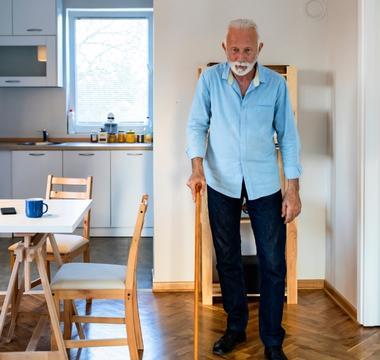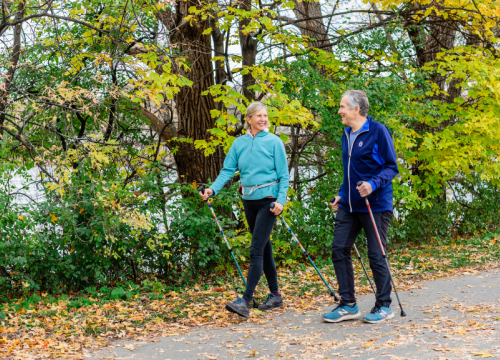Freezing of Gait: Comparing Treatments Options

The sudden, involuntary inability to move — that feeling of your feet being glued to the floor when trying to take a step — is called freezing of gait.
of people with mild Parkinson’s symptoms experience freezing of gait.
of people with advanced PD experience freezing of gait.
Freezing of gait is also associated with a reduced quality of life, loss of independence, increased wheelchair use, high rates of institutionalization, and mortality (Kwok et al., 2022b). The complex science behind what causes freezing episodes is not well understood. What is well understood is that while freezing can occur at any time, it usually happens when a person with PD is:
- Transitioning from standing to walking
- Walking through a doorway
- Turning a corner
- Turning around
- Stepping from one type of surface to another
- Experiencing a stressful situation or attempting multitasking

Comparing the effectiveness of interventions (behavioral techniques) currently prescribed to help manage freezing episodes (and which ones work best) would be valuable information for anyone managing Parkinson’s symptoms. Recently published in the Journal of Neurology, “Managing freezing of gait in Parkinson’s disease: a systematic review and network meta-analysis” (Kwok et al., 2022b) the authors sought to do exactly that, with some surprising results.
Drawing from multiple databases (between the years 1990 and 2021) to identify randomized controlled freezing behavioral management trials in the PD population, ultimately 46 studies were analyzed. The 11 most common techniques used to help recover from a freezing episode were compared:
- Gait training on a treadmill: walking using a motorized treadmill
- General exercises: non-freezing specific, generic physical exercises (such as stretching and resistance training)
- Conventional physiotherapy: muscle strengthening and balancing exercises
- Obstacle training: using obstacles to train, generally with a physical therapist
- Dual task training: doing two tasks at once; usually one mental and one physical
- Robotic-assisted walking: walking exercises wearing an exoskeleton device
- Real-time biofeedback: using a feedback machine to help guide behavior
- External cueing: using visual cues, such as stripes on floor; and verbal cues, such as walking rhythmically to a song or beat
- Action observation training: intently watching an action, then practicing that action
- Psychoeducation: educating people with PD about freezing, plus developing motivational, emotional and coping skills
- Mind-body exercises: working through coordination-oriented movements, such as Tai Chi, dance, yoga
- Care/control groups: group that was compared to above interventions, included those who receive routine PD care, unproven interventions, or no intervention at all
The study participants were approximately 63 to 80 years of age. Thirty-nine out of the 46 studies included gender information; 55% included participants were male. Importantly, across all included studies, age, gender, disease duration, disease stage, severity of movement symptoms, and severity of freezing was comparable.
The primary tools used were the validated Freezing of Gait Questionnaire (FOGQ) and the New Freezing Gait Questionnaire (nFOGQ), which measure the severity and impact of freezing in the daily lives of people with PD. A broad range of additional statistical analyses were also conducted. Unique to this analysis, all 11 freezing treatment approaches were simultaneously compared in a single analysis (analysis studies generally compare one or two interventions).
Results
- Obstacle training, gait training on treadmill, and general exercise all demonstrated immediate, real-life benefits compared to usual care.
- Overall, obstacle training had the greatest and most immediate positive effect, followed by gait training on treadmill and action observation training.
- Only people with mild to moderate PD experienced beneficial effects of freezing behavioral treatments.
What does this mean?
Obstacle training, gait training on treadmill, general exercise, action observation training, and conventional physiotherapy can provide immediate, real-life benefits for people with PD who experience freezing episodes.
As noted by the study authors, “Surprisingly, the positive effects of some commonly prescribed interventions for gait rehabilitation, such as external cueing, dual task gait training and mind–body exercises (including dance) were not evident in this analysis” (Kwok et al., 2022a).
That is not to suggest that these other commonly prescribed interventions are not effective. Rather, additional, robust studies are clearly warranted to help support evidence-based research directions and recommendations for improved freezing episode management.
If you experience freezing episodes, talk with your doctor about exploring the interventions that might work best for you. While some interventions (obstacle training, treadmill, physiotherapy) have been shown to have immediate benefits, the best intervention for you may also depend on availability, feasibility and cost.
Learn More
The Parkinson’s Foundation believes in empowering the Parkinson’s community through education. Learn more about PD and freezing by visiting these Parkinson’s Foundation resources, or by calling our free Helpline at 1-800-4PD-INFO (1-800-473-4636) for answers to your Parkinson’s questions.
Related Blog Posts

Walking with Parkinson’s: Freezing, Balance and Falls

Tips for Living Alone with Parkinson’s
